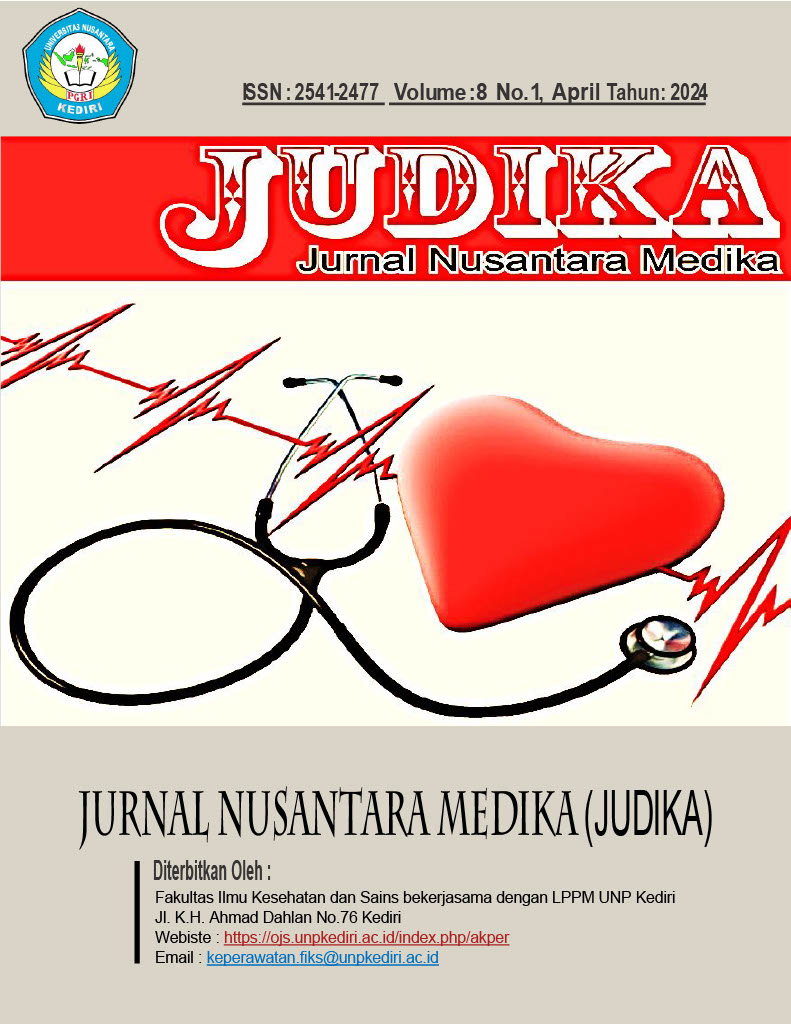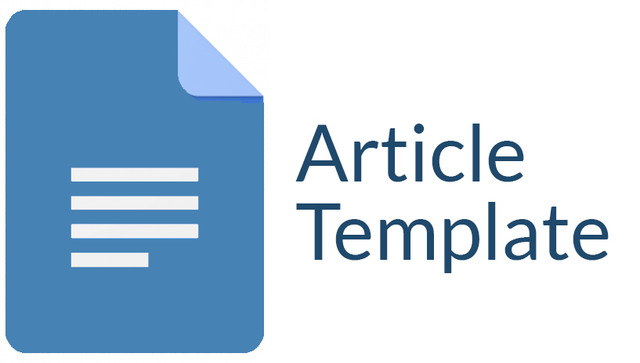STUDI TERAPI OBAT ANTIKOAGULAN PADA RESPONDEN POSITIF COVID-19 RAWAT INAP DI RSUD GAMBIRAN KEDIRI TAHUN 2021
DOI:
https://doi.org/10.29407/judika.v8i1.22554Keywords:
Covid -19, D-dimer, AntikoagulanAbstract
COVID-19 yaitu penyakit akibat mikroorganisme menyerang sistem pernafasan, penyebabnya yaitu infeksi virus corona-2 (SARS-CoV-2) yang dapat menular ke manusia dan menjadi pandemi sejak tahun 2020. Salah satu efek COVID-19 adalah hiperkoagulabilitas. Penelitian ini bertujuan untuk menganalisis pola kegunaan dan efektivitas terapi antikoagulan pada responden positif COVID-19 di ruang khusus isolasi RSUD Gampilan pada bulan Januari hingga Desember 2021. Desain penelitian yaitu observasional analitik retrospektif dengan desain cross-substudy dengan sampel sebanyak 95 pasien. Penelitian menunjukkan bahwa heparin (74,74%) merupakan antikoagulan yang paling umum digunakan dan dosis yang umum diberikan atau diresepkan pada pasien adalah 2 x 5000 IU (36,62%). Rute pemberian ketiga antikoagulan yang dipilih adalah pemberian subkutan atau dibagian hipodermis (100%), dan durasi pemberian yang paling umum adalah 4 hingga 6 hari (49,47%). Rerata penurunan D-dimer setelah pemberian antikoagulan adalah 1,411 μg/l pada kelompok pasien yang mengonsumsi heparin, 2,607 μg/l pada kelompok pasien yang mengonsumsi enoxaparin, dan 2,607 μg/l pada kelompok pasien yang mengonsumsi fondaparinux kelompok itu adalah 2.855 μg/l. Hasil uji statistik didapatkan terjadi perbedaan yang signifikan pada data D-dimer sebelum dan sesudah diterapi dengan diberikan antikoagulan untuk tiga kelompok responden dengan nilai sig sebesar (P<0,05).
Downloads
References
Billet, H.H, Gil- M.R., Symanski, J., Ikemura, K., et al., 2020. Anticoagulation in COVID-19: Effect of Enoxaparin, Heparin, and Apixaban on Mortality, Thromb Haemost, Epub, Vol. 120 No. 12, 1691–1699
Chen, N., Zhou, M., Dong, X., Qu, J., Gong, F., et al., 2020. Epidemiological and clinical characteristics of 99 cases of 2019 novel coronavirus pneumonia in Wuhan, China: a descriptive study, Lancet, Epub, Vol. 395 No.10223, p.507– 513.
Crowther, M. and Lim W., 2016, Use of Low Molecular Weight Heparins in Patients with Renal Failure; Time to Re-evaluate Our Preconceptions, J Gen Intern Med, Vol. 31 No.2:p.147–148
Cui, S., Chen, S., Li, X., Liu, S., and Wang, F., 2020. Prevalence of venous thromboembolism in patients with severe novel coronavirus pneumonia, J Thromb Haemost, Epub, Vol. 18 No. 6, p.1421–1424.
Riset Kesehatan Dasar, 2010. Badan Penelitian Dan Pengembangan Kesehatan Kementerian Kesehatan RI
Flaczyk1 A, Rachel P. R., Clay T. R., Brittany, K. B.K. et al., 2020. Comparison of published guidelines for management of coagulopathy and thrombosis in critically ill patients with COVID 19: implications for clinical practice and future investigations, Crit Care, Vol. 24:p.559.
Han, H., Yang, L., Liu, R., Liu, F., Wu, K., et al., C., 2020. Prominent changes in blood coagulation of patients with SARS-CoV-2 infection. CCLM, Vol.58 No. 7, p.1116–1120.
Hidayani, W. R., 2020. Faktor Faktor Risiko Yang Berhubungan Dengan COVID 19 : Literatur Review JUKMAS, Vol.4 No. 2, p.120–134.
IDI. 2020. Rekomendasi IDI Pemberian Antikoagulan Profilaksis pada Paisen Covid-19 yang Dirawat di Rumah Sakit. Jakarta
Ionescu F, Jaiyesimi I, Petrescu I, Laweler, P.R., et al., 2021. Association of anticoagulation dose and survival in hospitalized COVID-19 patients: A retrospective propensity score-weighted analysis. Eur J Haematol. Vol.106 No.2: p.165- 174.
Liu, K., Chen, Y., Lin, R. and Han, K., 2020. Clinical Features of Covdi-19 in Elderly Patients; a Comparison with Young and Middle-aged Patients. J Infect, Vol. 80 No.6: p.e14-e18
Kumar, C. V. S., Mukherjee, S., Harne, P. S., Subedi, A., et al., 2019. Novelty in the Gut : A Systematic Review Analysis of the Gastrointestinal Manifestations of COVID-19. BMJ Open Gastroenterology, Vol. 7(e000417), p.1– 9.
Levali, Y., Prastya, A. D. and Mawaddatunnadila, S., 2021. Coronavirus Disease 2019 (COVID-19): Patogenesis, Manifestasi Klinis dan Pilihan Terapi, Jurnal Kedokteran dan Kesehatan, Vol.17 No.1, p. 44-57.
Lodigiani, C., Iapichino, G., Carenzo, L., Cecconi, M., Ferrazzi, P., Sebastian, T., Kucher, N., Studt, J.-D., Sacco, C., Bertuzzi, A., Sandri, M. T., and Barco, S. et al., 2020. Venous and arterial thromboembolic complications in Covid-19 patients admitted to an academic hospital in Milan, Italy. Thrombosis Research, Vol.191, p.9–14.
Miesbach, W. and Makris M., 2020. Covid-19: Coagulopathy, Risk of Thrombosis, and the Rationale for Anticoagulation. SagePub- Clinical and Applied Thrombosis/Hemostasis. Vol. :26:
Moores LK, Tritschler T, Brosnahan S, et al., 2020 Prevention, Diagnosis, and Treatment of VTE in Patients With Coronavirus Disease 2019: CHEST Guideline and Expert Panel Report. Chest. Vol.158 No. 3 :p.1143-1163.
Nasiri, M.J., Haddadi, S., Tahvildari, A., Farsi, Y., Arbabi, M., et al., 2020. Covid-19 Clinical Characteristic, and Sex-Specific Risk of Mortality : Systemic Review and Meta-Analysis. Front. Med., Vol. 7, No. 459, p. 1-10.
Azizah, N.F., Faizah, R.N., Primasanti, D., Prihartini, I.K dan Romadhian, I.G., 2022. Efektifitas Penggunaan Enoxaparin dan Fondaparinux Sebagai Antikoagulan Pada Pasien COVID-19 di RSUD Sidoarjo. Majalah Farmaseutik Vol. 18 No. 1
Oliynyk O, Barg W, Slifirczyk A, Oliynyk Y, et al., 2021. Comparison of the Effect of Unfractionated Heparin and Enoxaparin Sodium at Different Doses on the Course of COVID-19-Associated Coagulopath, Life, Vol.11, 1032.
Patel, J.P., Roberts, L.N. and Arya, R., 2011. Anticoagulating Obese Patients In The Modern Era. Br J Haematol. Vol.155 No. 2: p.137–49.
Perhimpunan Trombosis Hemostasis Indonesia. 2018, Panduan Nasional Tromboemboli Vena Vol. 1-101.
Poterucha, T. J., Libby, P., and Goldhaber, S. Z., 2017. More than an anticoagulant: Do heparins have direct anti-inflammatory effects? Thrombosis and Haemostasis, Vol.117 No. 03, 437–444.
Russo, V., Cardillo, G., Viggiano, G.V., Mangiacapra, S., et al., 2020. Fondaparinux Use in Patients With COVID-19: A Preliminary Multicenter Real-World Experience. J Cardiovasc Pharmacol: Vol 76, No. 4
Salazar, J. Barochiner W.E., 2020. SARS-CoV-2 Infection Depends on Cellular Heparan Sulfate and ACE2.AnnOncol. Vol. 2, p.5
Satuan Tugas Penanganan COVID-19, 2022. Percepatan Penanganan COVID-19 di Indonesia, Jakarta
Setiadi, F., Panjaitan, D., dan Aviatin, M., 2022. Effect of Anticoagulant Use on Reducing D-Dimer in COVID-19 Patients. The Indonesian Jounal Of Infectious Disease, Vol. 8 No.2. STIKES Prima Indonesia.
Spyropoulos, A.C., Levy, J.H., Ageno, W., et al., 2020, Scientific and Standardization Committee communication: clinical guidance on the diagnosis, prevention and treatment of venous thromboembolism in hospitalized patients with COVID-19. J Thromb Haemost. Vol.18 No. 8: p.1859 –65.
Srivastava, S., Garg. I., Bansal, A. and Kumar B., 2020. COVID-19 Infection And Thrombosis. Clin Chim Acta. Vol.510:p. 344-346.
Tambunan KL, Pangalila FJW, Hutajulu SV, Bur R, Junar DA, Tobing DP., et al., 2019. Konsensus Penatalaksanaan Tromboemboli Vena (TEV). Vol.1–9.
Tandon, R., Sharp, JS., Zhang, F., Pomin, VH., Ashpole, NM., Mitra, D., et al., 2021. Effective Inhibitionof SARS-CoV2 Entry by Heparin and Enoxaparin Derivatives.J Vol. 95 No.3: p.1–12.
Tang, N., Bai, H., Chen, X., Gong, J., Li, D., and Sun, Z., 2020. Anticoagulant treatment is associated with decreased mortality in severe coronavirus disease 2019 patients with coagulopathy. J Thromb Haemost, Vol.18 No.5: p. 1094–9.
Tang, N., Li, D., Wang, X., and Sun, Z, 2020. Abnormal coagulation parameters are associated with poor prognosis in patients with novel coronavirus pneumonia. Journal of Thrombosis and Haemostasis, Vol.18 No. 4, p.844–847.
Thachil, J., Cushman, M. and Srivastava, A.A., 2020. Proposal for staging COVID-19 coagulopathy. Research and Practice in Thrombosis and Haemostasis. Vol. 4(5):731-736.
Thachil, J., Tang, N., Gando, S., Falanga, A., et al., 2020. ISTH Interim Guidance On Recognition And Management Of Coagulopathy in Covid‐19. Journal of Thrombosis and Haemostasis, Vol.18 No.5, p.1023–1026.
Turpie, A.G.G., 2006. Fondaparinux In The Management Of Patients With ST-Elevation Acute Myocardial Infarction. Vascular Health And Risk Management, Vol.2 No.4; p.371–378
Usach I., Martinez, R., Festini, T. and Peris, J.E., 2019. Subcutaneous Injection of Drugs: Literature Review of Factors Influencing Pain Sensation at the Injection Site, Vol.36 No.11; p.2986-2996.
WHO, 2020. The coronavirus disease (COVID-19) and the virus that causes it. Geneva.
Willim, H. A. Hardigaloeh. A.T., Supit, A.I dan Handriyani, H., 2020. Koagulopati pada Coronavirus Disease - 2019 (COVID-19 ): Tinjauan pustaka, Intisari Sains Medis, Vol. 11 No.3, p. 749– 756
Yao, Y., Cao, J., Wang, Q., Shi, Q., Liu, K., et al., 2020. D-dimer as a biomarker for disease severity and mortality in Covid-19 patients: a case control study. Journal of Intensive Care, Vol.8 No.1, p.49.
Downloads
Published
Issue
Section
License
Authors who publish with this journal agree to the following terms:
- Copyright on any article is retained by the author(s).
- The author grants the journal, right of first publication with the work simultaneously licensed under a Creative Commons Attribution License that allows others to share the work with an acknowledgment of the work’s authorship and initial publication in this journal.
- Authors are able to enter into separate, additional contractual arrangements for the non-exclusive distribution of the journal’s published version of the work (e.g., post it to an institutional repository or publish it in a book), with an acknowledgment of its initial publication in this journal.
- Authors are permitted and encouraged to post their work online (e.g., in institutional repositories or on their website) prior to and during the submission process, as it can lead to productive exchanges, as well as earlier and greater citation of published work.
- The article and any associated published material is distributed under the Creative Commons Attribution-ShareAlike 4.0 International License













